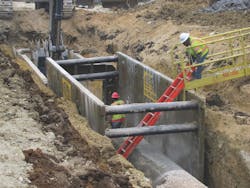Quoting from a recent OSHA (Occupational Safety and Health Administration) Fact Sheet seems a good way to introduce the topic of trench safety.
“Excavation and trenching are among the most hazardous construction operations. OSHA defines an excavation as any man-made cut, cavity, trench, or depression in the earth’s surface formed by earth removal. A trench is defined as a narrow underground excavation that is deeper than it is wide, and is no wider than 15 feet. Cave-ins pose the greatest risk and are much more likely than other excavation-related accidents to result in worker fatalities. Trench collapses cause dozens of fatalities and hundreds of injuries each year.”
More Information on Trench Safety
Contractors who send workers into trenches have a legal obligation to ensure the safety of those workers, either by complying with the OSHA standard for excavations—Part 1926/Subpart P/Sections 1926.650-652—or with applicable state standards. The OSHA standard address all aspects of trench safety, including protecting workers from trench collapse (cave-in), safe access/egress, hazardous atmospheres, adjacent-structure stability, and the requirement for an on-site “competent person,” who “must be able to identify hazards and must have authority to take appropriate corrective action.”
Compliance with the provisions of Subpart P is, however, not universal among excavating contractors.
“A review of recent trenching violations would suggest that compliance to the standard, now in its 26th year, is still less than 50 percent,” says Wendell Wood, an excavation-safety consultant and trainer with 40-plus years in the industry. “Failure to provide a protective system and failure to properly handle spoil [which must be at least 2 feet from the trench] remain top citations. Trench-access/egress provisions continue to be violated, as are provisions requiring a competent person to daily inspect the excavation and its protective system.”
More recently, says Wood, failure to provide awareness training for new hires is of increasing concern. “New employees might find themselves immediately at the bottom of a trench,” he says, “with no idea of the multiple hazards they face.”
Competent persons
Jay Goff, safety director for the Hazel company, lists other non-negotiable safety procedures the company has in place. “We require a valid ‘miss utility’ ticket for the work area with all utilities properly marked. Marked utilities are test-pit located and exposed prior to excavation. A competent person must be on site to ensure that OSHA laws and company policies are enforced.”
In Wood’s opinion, the selection of a competent person is a primary safety consideration on any excavation project. “Contractors should make a concerted effort to designate a competent person who has the experience to assess the job site and surrounding areas with an eye to potentially hazardous situations. It’s a mistake, in my opinion, to place this responsibility on whoever is willing to accept it. In my experience, only a small segment of typical work crews has the force of character to take action when they see something unsafe.”
If the competent person is called away from the site for whatever reason, says Wood, the contractor should have designated another member of the crew to be ready to step into the role. “If such provisions are not in place,” says Wood, “the competent person must have the courage and authority to stop work until someone with the required experience is available. A company really should have procedures and protocols in place to handle these situations.”
Hazardous Atmospheres
When Construction Equipment asked Wood to identify other areas of trench safety that the competent person must keep in view, he noted hazardous atmospheres. Subpart P, section 1926.651(g), addresses air quality in excavations, and refers the competent person to 1926 Subparts D and E, which cover environmental controls and personal-protective and life-saving equipment. In some instances, air-quality testing is required before workers can enter an excavation, and respiratory protection or ventilation might be required.
“[Hazardous atmospheres] have not been a focus on the part of compliance officers,” says Wood, “but I think it will become an issue in the coming months with the publication and now enforcement [August 2015] of the new Confined Spaces in Construction standard.”
Although the scope of the new standard, 1926 Subpart AA, officially exempts construction work regulated by Subpart P, some think it might have implications that excavating contractors should keep in mind, especially if in the course of their work confined spaces are created, such as manholes.
Training
Wood also encourages excavating contractors to establish a policy of ongoing training for those employees who work in trenches.
“Training—not just when it’s convenient, but continuous training for all, with the participation of management, and in a language that workers understand—is the single best asset for developing a culture that communicates a genuine desire to have safe work sites. Such a culture demonstrates to employees that safety is simply not lip service, but is instead a priority, motivated by doing the right thing for employees.”
Companies that practice this principle, says Wood, have discovered that it produces a stable, dedicated work force that works productively and profitably.





